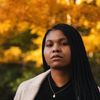
The glitz and glamour of entertainment is nothing without the people who dress today’s biggest stars. For “Who’s Behind the Clothes,” HuffPost spotlights stylists and costume designers who have delivered some of our favourite celebrities or characters’ most memorable looks.
Before Colleen Morris-Glennon led costume design on the hit series Industry, she styled the ‘Queen of Disco’ Donna Summer while working at MTV in her mid-20s. And before that, Morris-Glennon was an 8-year-old in Jamaica enamoured with the clothing in West Side Story — and taller than most her age.
“How I started making clothes is actually making it for myself, because I didn’t want to look like a ‘high water girl.’ My dad’s favourite line was, ‘You expecting a flood?’” Morris-Glennon, who is 5’10”, said with a laugh, recalling pants that fit like capris.
It was working with the late Summer — dressing her for performances, a 1999 Genre magazine shoot and more — that inspired Morris-Glennon to do more than styling. Once the TRL era took off, the British-Jamaican stylist knew it was time to transition out of live television. That leap of faith turned her into the triple threat she is today.
With over 30 years in fashion and over 20 years of television and film expertise, the London native is bringing the art of tailoring back to television. Morris-Glennon has worked on the off-Broadway musical rendition of Rent, the 2004 film Eternal Sunshine Of The Spotless Mind and, notably, Bolden, a 2019 movie based on the life of New Orleans jazz musician Buddy Bolden.
“I ended up becoming assistant designer, then after a while, I got promoted to a costume designer” thanks to the film’s director, she said. “I got to really take all my experiences of fabrics, construction, knowledge of design and costumes and put it into that piece. That’s when I realised I’m not doing anything else but costume designing ever again.”
Morris-Glennon talked to HuffPost about her journey through costume design and why working on Industry was a match tailor-made in heaven.

From working with Donna Summer to leading costume design on Industry, how do you bridge the differences between styling for the stage versus television?
With styling, especially, it is an absolute collaboration between you and your client. It is not just what you think; it has to be what the client likes, what the client is comfortable wearing. Because you might have an idea that this person will look so good in this item, and they go, “Actually, I don’t like my arms out.” You have to work with those instances.
Then there is the stage. That means very different fabrications. That means things that will stand up to hard work, stretch. It’s so much more thought that goes into styling than people actually realise. It is an art form, and it’s so much harder because you have to build a relationship with your clients. They have to trust you in a way because you’re putting them in something that they’re going out into the world in. No one’s gonna say, “Ooh, what stylist did that?” They’re going to go, “What the hell is she wearing?” There is a trust that has to come between you and your clients as a stylist. It is about your book: Who can you call? But also it depends on the actor or the celebrity because if they’re big enough, they also open doors for you.
What was it like working with Donna Summer?
I miss her every day. She was the kindest, sweetest soul. She was an amazing human being. Within five minutes of being in her presence, you forget who she is, because she’s just another person talking to you. She gave me such confidence. When I styled her for a magazine called Genre, it was the first time I worked with her. I was working with a stylist Jimmy Hanrahan, who then couldn’t do it, and he gave me the project. I was so nervous, because I’m in my 20s and I knew, in my head, I wasn’t at the caliber to be styling Donna Summer. She made me feel absolutely comfortable.
Being a West Indian, when you’re going for a shoot with Donna Summer, you’ve got to dress up. So I did, and I was wearing something that I designed myself. She was like, “What is that? Why am I not wearing that?” I was like, “Oh no, no, no, I made it. It’s not good enough for you. I made it.” She goes, “What does that mean, Colleen? Did you design and make it?” I said yes and she goes, “Then you’re a designer.” I remember that day so well. She held my hand and she goes, “You need to own it.”
She felt more of a friend than a client. Every time I spent with her and her husband were moments I will treasure and never, ever take for granted that I got to work with her. The most iconic pieces I did for her were pieces that she wore for the VH1 Divas in 1998. My mom and I made those costumes. I’ll always love that. She was like, “Would you like to do my build my costumes for ‘Divas?’” Meanwhile, I had Dolce & Gabbana, all these designers calling me for her to wear them, and she was like, “No, I’ll wear you.”
Tell me a little about your journey to costume design. Who inspired you to enter the industry?
My first and always No. 1 reason for being in this industry is my mother. When I was growing up, my mother was a really amazing dressmaker. I just idolised her in every way. For my 4th birthday, I got a play sewing machine, so I sat beside her and her machine with my hand wheeling, making doll’s clothing. That’s where it really started.
In costume design, it would be Irene Sharaff, the costume designer who did the original West Side Story. The first time I watched that film, my mum remembers it because the image of those costumes and Rita Moreno in that lavender dress was my moment of knowing I wanted to do that. It wasn’t until I returned back to England in the ’80s that I saw West Side Story in colour, and saw the lavender dress with all the layers of beauty underneath it for real. That was my first moment of really wanting to be in costume, not knowing how that would work.
Growing up in England, there was never really an outlet for costume design. It was never something that I thought of. So I went into fashion design, which was also a great love of mine, went to university, got my master’s degree, worked with a master tailor from Savile Row, became a tailor and kind of fell into costume design by accident, which is great.
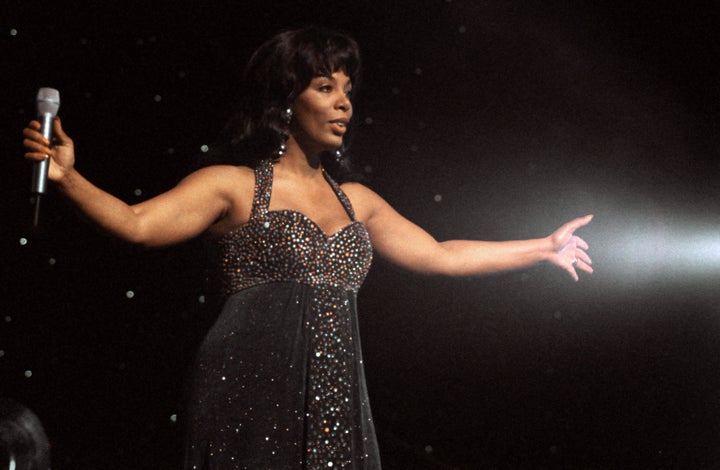
What was your experience like attending Central Saint Martins? Growing up, I remember watching Project Runway, and hearing what an esteemed institution it is.
My educational journey was from being in art school in my actual school. I was lucky enough to have a really good art teacher who took an interest in, then, my drawings. Then going to college and working on that, but I really wanted to go to Central Saint Martins. I never really thought I had any hope of going, but that was like reaching for something that you know you can’t possibly reach — and I got in. I have to admit, it wasn’t the most enjoyable experience as a person of colour. I feel like I survived it. You’re talking about the late ’80s, early ’90s, and there weren’t many people of colour.
I left there kind of jaded and unsure of what to do next. I luckily went to see my mum in America after my parents divorced. I went to a nightclub and met this amazing man: Jimmy Hanrahan, who was then the head stylist at MTV. That was the first time I felt like I belonged. I couldn’t believe that they would pay me money to go shopping. I had no clue what it meant, and I enjoyed it so much. I was there for so many years. That really, for me, was more my actual training because that was the first time I really worked with a lot of beautiful clothing, and realised how much people didn’t know about construction. That enabled me to get work that I would never dream of getting. I was the stylist and costume designer for Donna Summer. The knowledge of construction will always be central to what I do. My career really started in New York, when I moved to New York in the early ’90s.
How did your Jamaican parents respond when you said you wanted to pursue a career in costume design?
My mum was totally into it. She comes from that very artistic background anyway. My mum was always like, “You can do whatever you want to do. Put in the work, you can do it.” I wanted to just make fun clothing as a kid and she’s like, “No, this is how you do it. This is what you do. No, you’re not going to finish it by putting a pin in it and running out the door — you’re going to finish it.” My mum really taught me the art of finishing what you start and making sure I had the ability to make clothing, not just to design something on a piece of paper and say, “Yes, this is beautiful.” So that was her job.
My dad? Not for it. He didn’t see the value in it. He was always very artistic; he comes from a background of farming, but he was a brilliant landscape artist. It took until he was in his 40s to get any work as a landscape artist, so he did not want me to go through that. He didn’t perceive a little Black girl, working class, ever being able to do what I’m doing now. I realised he wasn’t mad. It was fearful, the thought of me not having an education that I can use and move forward. It took years for me to realise he wasn’t angry with me. He was just afraid.
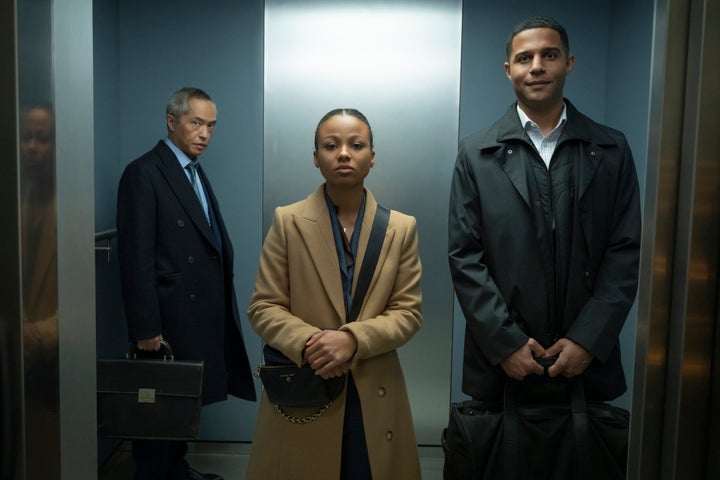
How would you describe your personal sense of style, and how has your Caribbean heritage impacted it?
My personal style stems from my parents. My mom was kind of bohemian. She loved reggae music in the ’70s, which when Bob Marley started, it was not accepted in the West Indies. My mom was always that bell-bottoms-wearing, Afro woman. My mum was always that kind of earthy, organic personality. My dad was far more rigid. My dad wore suits to the cinema. He believed in a suit; he liked hats and walking sticks. It’s quite funny to grow up with these very different parents, so I guess that’s why I love tailoring, but I also love draping.
My dress sense is a mood dress sense. I wouldn’t say I have a sense of style per se. I definitely love classical clothing, so I will always be seen with a jacket, something tailored and then something soft. I love fluidity, and I also love structure. It’s really how I feel on that day. If I’m feeling slender and feeling good, then I’ll go crazy. If I’m not, always tailoring. I’m covering everything.
It’s quite funny because growing up in England, I wore a lot of black. Then when I moved to America — where they actually have summers — I started wearing more color, which was kind of wild. I never thought I would wear color. In the winters, I’m definitely more muted. I just think black is the best color anyway. Everyone’s like, “Black is not a color,” and I’m like, yes it is!
What was the hardest part about transitioning from tailoring into costume design as a Black professional in the industry?
It was very hard for me because no one wanted to help. Everyone was like, “Oh, but you’re such a good tailor. If you become a designer, then I’ll lose my job.” It was quite interesting, the lack of help there was for a person of color. I had to literally go out and go in through the back door to get in. Even after I did that job, it was still hard for me to find work as a designer. I had to come back to England to get work.
It’s been a challenge. I still haven’t worked in America again since as a designer. I hope I will, but it’s a hard climb. It’s much more open now, and I’m relieved. I’m sad for the circumstances that it took for them to see Black people, not just in our industry, but so many industries. It feels great that we’re doing it, but there is such a bitter aftertaste to realize what it took to be seen.
I’m very happy to see all the Black people that are now these HODs — head of departments — costume designers, production designers, directing, all these positions now. But I am hoping that it comes with support. I’m lucky enough that I’ve been in this industry for a very long time, from your PA to your costume designer. That is my great fear now, with making sure there is help for them as they’re pushed forward, because it’s hard to go from not getting anything to getting everything. If there’s no infrastructure set up to support you, you’re set up to fail. Then afterward, what they will now say is, “Oh, they couldn’t do it.”
Tell me about your journey to “Industry” — and mastering the “Stealth-Wealth” aesthetic that Vogue attributes to you.
I worked on only the second season. When I got interviewed by Mickey Downs, Konrad Kay and the showrunner David P. Davis, they asked me to watch the first season before I did the interview. I watched the first season — loooooved Industry — but I could see what I could do to change it. I just spoke to them and I was like, “I know you want it to stay exactly the same. But I think you need to change it just a little bit. I find it doesn’t look wealthy enough.” That doesn’t mean different colours, that doesn’t mean anything but it means a cut of clothing, especially in the men’s suits. It means that cut. They were very adamant about keeping it real. But when you look at those finance and banker guys, especially the older guys, they’ve been in the business so long.
Back in the day, apart from in the last 10 years maybe, before then, most of those suits were from Savile Row. They have learned how to dress well from the tailors who are making their suits. As for the cuts, they’ve learned that from them. I said there just needs to be that element of wealth within the clothing. It was easy for me to do that being a tailor. That was second nature.
I mean, this show was literally tailor-made for me to do. It was making sure there is an echelon or layers of what the suits, especially, would look like, from your first years to your third years to the guys in the offices upstairs. There has to be an absolute stepping stone where you can see the difference in cut, in fabrics, in the way they wear it, in the size of the jacket. Because some of the younger guys will have the wealthy jackets, but it won’t be the right fit and won’t be the right cut.
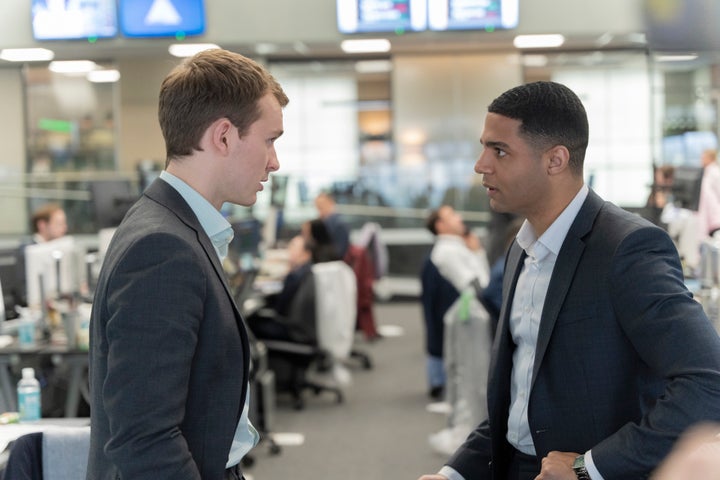
I definitely noticed that sort of haphazard neatness with Harry Lawtey’s character, Robert Spearing. Robert is trying so hard to find his way, period, and it’s evident in how he dresses. Who was your favorite character to style on the series?
I want to say Harper. Harper is such a complex character. There’s so many layers to Harper. I have to say I enjoyed the fact that she was American. She was in England. I enjoyed the fact that she was basically working class, and just trying to get in there and trying to do this job that she knows she’s good at. The first season, she had the “off the boat” look. I don’t think she was prepared for the world that she was entering, especially in Britain with the class system. It’s a world! She learned that quickly, which is why she and Robert got on so well. Because he’s working class. She’s working class, and they got each other. They got the angst; they got the pain.
He definitely has that big brother thing with Harper. They are one of my favorite relationships in the show from the first season. I loved costuming Harper, giving her from the first year to the third year. She spent a long time living with Yasmin, so she learned so much from just living with Yasmin that she would have not learned in years of living in England. Yasmin is royalty, she’s a Chelsea girl, she’s an heiress, she comes from money. Whether Harper realized it or not, she picked up on that. I definitely kept her clothing very much like she was in the first season: very clean, very concise. The color palette did not waver much, because Harper doesn’t care about that.
Whereas Yasmin incorporated a lot more color and was far more playful.
Because Yasmin was like, “Okay, I suffered the first year under Kenny. I’m not doing that anymore.” And she came back with that attitude. The great thing is they had the year off at home, so they had time to think and to be. She just came back, and she was like, “No.”
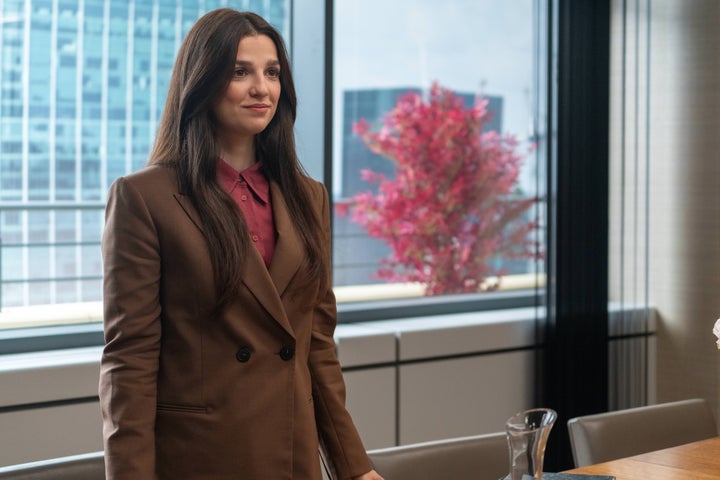
Speaking of clothes, were there specific labels, designers or brands you pulled and frequented for the series? Who are some of your personal favorites?
I’m definitely a fan of Margiela. I put a bit of Margiela on Harper, because I find the cut of the clothing is very Harper. When she was in Berlin, that beautiful coat she was wearing was a Margiela coat. I frequent Yves Saint Laurent for Yasmin — of course, she had the best labels. Hello, it’s Yasmin. Rishi was also another label whore, because he is the male label whore. I used a lot of Moncler on him. Eric was a lot of Brioni; he was like old school, like Hugo Boss. There’s something about Hugo Boss I love because they have like no other brand of men’s tailoring, to me, where they have from the very expensive to the affordable. Between the first-year students and the echelon at the top, I was able to use Boss. They were very helpful to us; they gave us discounts. I loved Rupert Sanderson for shoes, always Stuart Weitzman for shoes. I’m a fan of the old-school French labels because no matter what, no matter how modern they get, there’s always that sense of classic to them. You don’t feel like an idiot wearing it two years from now.
I’m not a fan of throwaway fashion. I would rather buy last season’s designer wear than this season’s because that’s what I can afford. I grew up that way; I believe in classics, I believe in good fabrics. Not all of us can afford designer labels — I certainly don’t — I believe in buying last season’s something. But tailoring it makes or breaks an outfit.
What is one of your fondest memories designing on the “Industry” set?
Our budget was not big. It looks like it was big. It was not. I had my kit, which is basically previous collections of my clothing, with me. I beg, borrowed, called in favors to really get the show to look as it should. One of my favorite memories was Celeste’s character because she’s supposed to look so expensive. I was like, “How much is our budget for Celeste? Okay, this should be interesting.” I was like, “You know what? I’m gonna go grab everything I’ve ever designed out of my kit.” We had nothing for her and during the fitting, I’m like, “We’re gonna throw something on the wall, and something will fit.” [Katrine De Candole] walked into the room, and everything she put on fit her perfectly. I was standing there with my supervisor, Sophie. I looked at Sophie, Sophie looked at me, and she was just like, “How is this possible?”
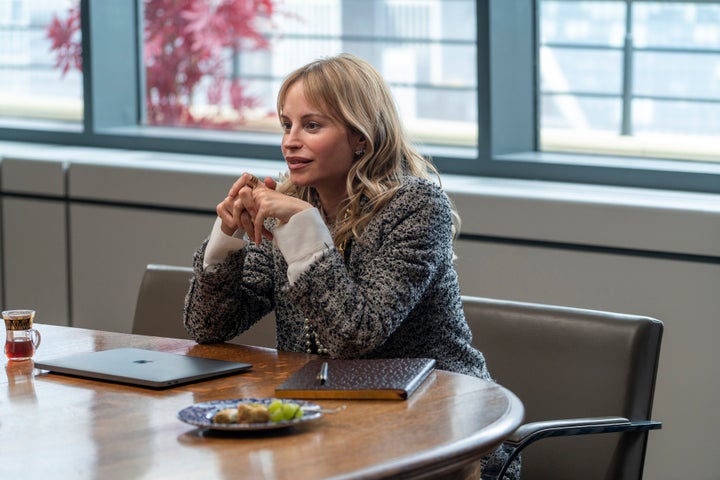
So, 90% of what she’s wearing is literally from my past collections and from my kit. That was such a money-saving experience because then I could put more money on the other characters. That was a moment of zen. That will never happen again in my career, where literally we had too much clothing. We went from having nothing to too many looks for her. The Chanel suit [she wore], we made that because there’s absolutely no way Chanel is going to lend us clothing — and obviously, we can’t afford it. I literally had the Chanel fabric that I’ve had in my kit for maybe 10 years and was like, “We’re building her Chanel suit.” That was the moment that I enjoyed the most: being able to get her things out of nowhere, out of nothing.
What are you working on now, and where do you hope your career goes next?
What I’m working on now is a series called “Hijack” with the ever-so-lovely Idris Elba. He’s absolutely lovely. It’s very hard being a Black designer, getting to do British period. I would love to do period. Tailoring and contemporary comes from my knowledge of fashion, but what I love to do as a designer is definitely period. I would love to do something that’s period-based but in actual fact.
If it’s a good project, I don’t care. I just want to do good projects. “Industry” was a marriage made in heaven. It really was.
